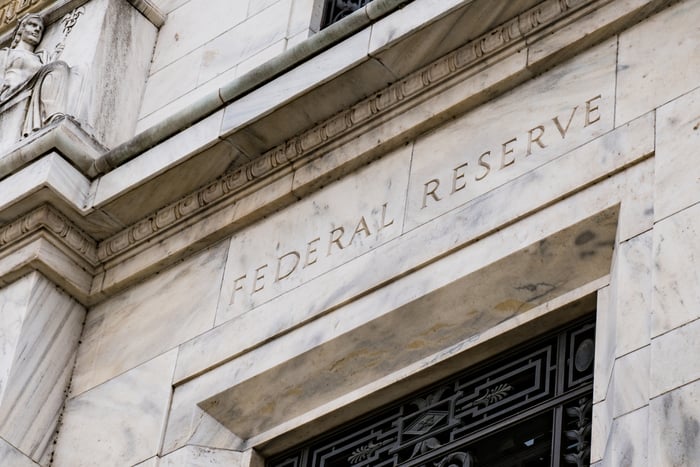The Federal Reserve's long-awaited pivot finally came in September.
After months of anticipation, the central bank surprised investors by cutting the benchmark federal funds rate by 50 basis points to a range of 4.75% to 5%. Some economists thought a 50-basis-point cut was too aggressive -- that level, essentially a double cut, is typically reserved for economic crises like the great financial crisis or the pandemic, or when the economy seems to be heading to a recession.
Federal Reserve Chair Jerome Powell attempted to stave off those concerns, saying, "The U.S. economy is in good shape," and the aggressive interest rate cut is designed to keep it there, supporting labor market growth.
Investors wondering how interest rate cuts will affect the artificial intelligence (AI) stock sector got a taste of things to come on Thursday when tech stocks soared, especially those with AI exposure. The VanEck Semiconductor ETF, which is made up of top AI chip stocks like Nvidia (NVDA -3.00%) and Taiwan Semiconductor Manufacturing, jumped 4.3% on Thursday.
Rate cuts tend to be good for stocks in general as lower interest rates make fixed income less attractive, leading bond investors to rotate back into stocks. They also help encourage economic growth by making it easier for companies to borrow and lowering interest expenses on existing debt, which also favors stocks since they are a cyclical, economically sensitive asset class.
Beyond that, the historical record isn't that clear on the impact of rate cuts on tech stocks and AI stocks. There haven't been that many rate-cut cycles in modern history, and every one is different. Some are caused by extreme circumstances like the pandemic or the great financial crisis, while the current one seems more pedestrian.
Still, using history as a guide, let's take a look at what the beginning of the rate cut cycle means for some of the top AI stocks on the market.

Image source: Getty Images.
1. Nvidia
No AI stock has gotten more attention during the bull market than Nvidia, and for good reason. The stock has skyrocketed since the start of 2023 shortly after ChatGPT launched as demand has soared for its GPUs, and the company is now the third-most valuable company in the world, behind Apple and Microsoft.
Nvidia has been through multiple rate-cut cycles since its initial public offering (IPO) in 1999. In the first one, as the federal funds rate plunged from about 6.5% at the start of 2001 to about 1.6% at the end of that year, Nvidia stock nearly quadrupled, though the stock would give up all of those gains in the next year as the bear market driven by the dot-com bubble churned on.
Later, as rate cuts began again in 2007 ahead of the financial crisis, Nvidia stock fell more than 80% from peak to trough as tech stocks and chip stocks also plunged on fears of a financial collapse.
Finally, Nvidia gained during a rate-cut cycle in 2019 that preceded the pandemic, and then jumped again in 2020 as rates plunged once COVID-19 swept the country. That performance tracked with the broader chip industry.
Based on the historical record, Nvidia's performance during rate-cut cycles is best analyzed on a case-by-case basis. The historical example that seems most similar to the current environment is 2019 when the economy was solid and unemployment was low, but the Fed cut rates due to risks from ongoing trade wars with China and other countries, seemingly anticipating that they could negatively impact the economy.
Nvidia stock soared through the second half of 2019 as the federal funds rate came down by 75 basis points. While that situation isn't directly analogous to the current environment, it should give investors some confidence that this rate cut cycle will be a net positive for the stock.
2. Palantir
Palantir (PLTR -1.42%) is a much different company from Nvidia, but the cloud software company known for deep data analytics has emerged as one of the big winners in the AI boom and is up close to 500% since the start of 2023.
Unlike Nvidia, Palantir doesn't have a long track record in the stock market. The company went public in 2020, so this is the stock's first rate-cutting cycle. Like most tech stocks, shares plunged during the 2021-2022 bear market when the Fed started raising rates. However, there is some evidence that Palantir will benefit from rate cuts even as the stock rose just 1.2% on Thursday, underperforming the broad market.
The primary evidence is the performance of high-priced cloud software stocks during the 2010s, a decade when interest rates were near zero much of the time. Many of those software-as-a-service stocks soared, even though they were unprofitable, and their multiples expanded to ratios not seen since the dot-com boom.
Palantir is unlikely to see the same kind of benefit, as the federal funds rate isn't expected to fall back to zero, but the stock has already earned a lofty and arguably unjustified valuation at a price-to-sales ratio of 35.
That's largely due to the company's own execution and soaring profitability, but the cloud software sector has historically been one of the biggest winners from interest rates falling, which should support Palantir's high valuation or even lead to its expansion.
Rate cuts, in other words, should help assuage concerns that Palantir is vulnerable to a sharp pullback, but the company will have to continue delivering strong profit growth to meet investors' high expectations.





